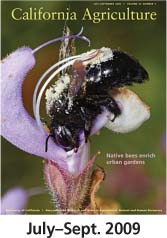All Issues
Letters: April-June 2010
Publication Information
California Agriculture 64(2):53-53.
Published April 01, 2010
PDF | Citation | Permissions
Full text
IPM for LBAM
I just read the article on integrated pest management (IPM) for the light brown apple moth (LBAM) in New Zealand, and I want to thank you for publishing this research (“New Zealand lessons may aid efforts to control light brown apple moth in California,” by Lucia Varela et al., January-March 2010).
It is such a relief and pleasure to me to see documented — in a peer-reviewed scientific journal by a team with such excellent credentials — what the literature on LBAM and the experience Jan.-Mar. 2010 in New Zealand tell us about the real risk (or lack thereof) posed by LBAM and the effectiveness of simple, low-impact IPM methods for managing LBAM, if management is needed.
I sincerely hope that this research on parasitoids for LBAM will lead to a much more rigorously science-based approach that will result both in relieving farmers of burdensome quarantines and in ending the costly, unnecessary, and likely also dangerous and ineffective eradication program that the state has been promoting.
Nan Wishner, Chair Emeritus
Integrated Pest Management Task Force, Albany, CA
Amazing urban bees
The photo on the cover of the July-September 2009 issue of California Agriculture (“Native Bees Enrich Urban Gardens”) is amazing (and many of the inside photos are great, too). Was that shot by a researcher or by someone on the magazine's staff?
I just wanted to let you know the magazine looks great.
Kevin Leigh Smith, Editor, Agricultural Communication Purdue University, West Lafayette, IN
Editor's note: The cover photograph was shot by Rollin Coville, an environmental entomologist, photographer and member of Gordon Frankie's research team at UC Berkeley.
I read California Agriculture (July-September 2009) closely enough to have noticed the ACE award you won, so here's a hearty congratulations. Well-deserved, and has been for a long time. I was reading it while eating my bacon and eggs this morning. Not sure how holistic that is, but I thank the farmers and animals.
The article on urban bees (“Native bees are a rich natural resource in urban California gardens”) is on the very cusp. I have some friends who keep bees in the suburbs here. What I loved about your bee package was how much I learned about the many varieties of bees and their different life-strategies.
Joseph A. Davis, Writer-Editor Bethesda, MD
WHAT DO YOU THINK?
The editorial staff of California Agriculture welcomes your letters, comments and suggestions. Please write to us at 6701 San Pablo Ave., 2nd floor, Oakland, CA 94608 or calag@ucdavis.edu. Include your full name and address. Letters may be edited for space and clarity.






